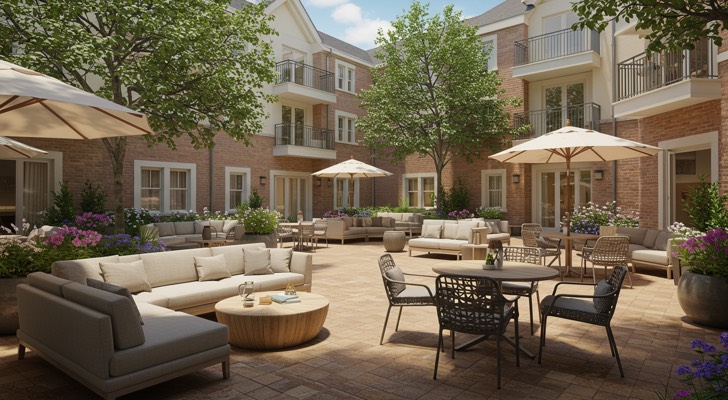
Affordable senior co-housing is a unique living style where older adults share a purpose-built community. Each person or couple typically has a private apartment or small home while common spaces such as kitchens, gardens, and recreation areas are shared. This setup reduces costs and fosters strong social connections.
Key Benefits of Affordable Senior Co-Housing
Affordable senior co-housing helps residents save money by sharing resources like utilities, amenities, and maintenance costs, making it more cost-effective than living alone or in other retirement options. It also fosters a strong sense of community, with plenty of opportunities for socializing, participating in activities, and supporting one another, which can help prevent isolation. At the same time, residents enjoy the independence of their own space while having a supportive network of neighbors nearby.
Costs of Senior Co-Housing
Senior co-housing is often more affordable than traditional assisted living or private retirement homes, but costs can vary depending on location, unit size, and amenities.
- Monthly Fees: Typically range from $800 to $2,500. Rural areas or smaller towns are generally at the lower end, while urban or amenity-rich communities may be at the higher end.
- Shared Expenses: Residents often share the costs of maintenance, landscaping, internet, and community activities. This can reduce individual expenses significantly.
- Long-Term Savings: On average, co-housing can be 20 to 40 percent more affordable than assisted living facilities, which usually range from $3,500 to $6,000 per month.
- Medical Costs: Most co-housing communities do not include healthcare, so residents need to budget separately for medical insurance, doctor visits, and any personal support services.
- Purchase Options: For communities where units can be bought, entry costs vary widely. Smaller towns may start around $150,000, while units in urban or high-demand areas can exceed $500,000.
Senior Co-Housing Cost Spectrum
Senior co-housing does not only have affordable options. While many communities are designed to reduce costs through shared spaces and resources, the price range can vary widely depending on location, size, amenities, and whether homes are owned or rented.
Here’s a breakdown:
- Affordable Options: Smaller towns or rural areas often have lower purchase prices or rents. Monthly fees typically cover shared utilities, maintenance, and community programming, making it cost-effective.
- Mid-Range Options: Suburban locations or communities with more amenities such as clubhouses, gyms, and pools may have moderate purchase prices or rent. Fees are higher but still generally lower than assisted living.
- Premium or Luxury Co-Housing: Urban or high-demand areas can command higher prices, sometimes comparable to condos or premium retirement apartments. Larger units, upscale finishes, and extensive amenities like gourmet kitchens, spa-like facilities, and concierge services increase costs.
In short, senior co-housing spans a spectrum from affordable to premium, so seniors can choose communities that match both their lifestyle preferences and budget.
Is Affordable Senior Co-Housing Right for You?
Affordable senior co-housing is a great option for older adults who want to maintain their independence while enjoying companionship, shared activities, and a supportive community. It suits those who prefer a cost-conscious lifestyle and want a budget-friendly alternative to traditional retirement homes.
Consider senior co-housing if you answer “yes” to most of the following:
- Do you want to live independently but avoid social isolation?
- Are you comfortable sharing some common spaces with neighbors?
- Do you enjoy community activities and collaborative decision-making?
- Are you seeking a more affordable alternative to traditional retirement homes or assisted living?
- Can you manage your healthcare and personal support needs separately from housing costs?
- Do you value a neighborhood where residents actively help and support each other?
If most of these points resonate with you, senior co-housing could be a perfect fit. It offers the chance to stay active, form meaningful friendships, and enjoy a strong sense of belonging. By choosing this lifestyle, you can live independently while benefiting from a community that looks out for one another, creating a balanced and fulfilling retirement experience.
Finding Affordable Senior Co-Housing Communities
Research local options through senior living directories, housing networks, and community listings. Visiting communities in person helps gauge daily life, amenities, and social culture. Review costs and contracts carefully to understand what fees cover. Creating a clear budget for housing, healthcare, and leisure activities ensures that the community is both affordable and sustainable long term.


